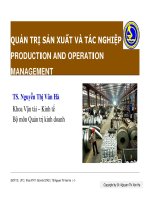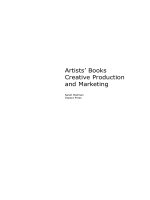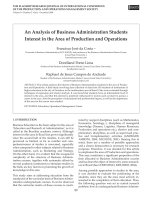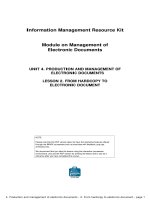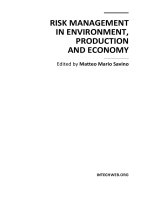Production and operations management boo
Bạn đang xem bản rút gọn của tài liệu. Xem và tải ngay bản đầy đủ của tài liệu tại đây (3.66 MB, 284 trang )
This page
intentionally left
blank
Copyright © 2008, 2006 New Age International (P) Ltd., Publishers
Published by New Age International (P) Ltd., Publishers
All rights reserved.
No part of this ebook may be reproduced in any form, by photostat, microfilm,
xerography, or any other means, or incorporated into any information retrieval
system, electronic or mechanical, without the written permission of the publisher.
All inquiries should be emailed to
ISBN : 978-81-224-2425-6
PUBLISHING FOR ONE WORLD
NEW AGE INTERNATIONAL (P) LIMITED, PUBLISHERS
4835/24, Ansari Road, Daryaganj, New Delhi - 110002
Visit us at www.newagepublishers.com
PREFACE TO THE SECOND EDITION
The second edition of the book Production and Operations Management incorporates
several suggestions offered by our colleagues and students all over the country.
In this edition we have endeavored to strengthen the basic characteristics of the book. The
subject matter has been presented systematically in ten chapters, which can enable the reader to
master the topics covered without any additional guidance. In keeping with the basic objective of
making the learning of the ‘Concept and Principles in Production and Operations Management’, the
following chapters have been revised as per the suggestions.
Chapter 1 on Introduction to POM was revised with the addition of Managing Global
Operations with the concept of globalization. Chapter 2 on Plant Location and Layout was
revised with locational models and the design of product and process layout. Service layout was
also included. Chapter 4 on Materials Management was revised with the addition of special
purchasing system. Chapter 6 on Quality Control was revised with the addition of ISO 14000
series along with the recognized bodies for ISO certification. Chapter 8 on Maintenance
Management was revised with the concept of Total Preventive Maintenance.
The revised edition also contains Caselets which provides additional input to understand the
subject with practical application of the techniques used in each chapter.
For the development of application skill of the theoretical knowledge of production and operation
management, it is necessary to arrange for a visit or conduct the project work either by individual
or group of students in a manufacturing or service organisation.
In this context the revised edition contains skill development/practicals in each chapter. For
this purpose the students are adviced to visit a Fast Food Restaurant like Pizza Hut or Pizza Corner
for getting the information for the questions given under skill development in each chapter.
In addition to the caselet, cases are given to understand the entire concept of production and
operations management at the end of the book.
Complete care has been taken to make the book error free. However, mistakes might have
crept inadvertently. Readers finding any error are requested to bring it to our notice, for enabling
us to rectify them in our future editions.
We are grateful to New Age International (P) Limited, Publishers, and the editorial department
for their untiring effort to publish the book within a short span of time with a nice get up.
Our acknowledgements are also due to Dr. Poornima Anil Kumar and Mrs. Bharathi
Suresh, without whose support and sacrifice this work would not have been completed by the
deadline.
Finally, our acknowledgement is due to the Almighty who has blessed us with the knowledge,
required for writing this book.
AUTHORS
PREFACE TO THE FIRST EDITION
Production and Operations Management has been recognised as an important factor in a
country’s economic growth. The traditional view of manufacturing management is the concept of
Production Management with the focus on economic efficiency in manufacturing. Later the new
name Operations Management was identified, as service sector became more prominent. Rapid
changes in technology has posed numerous opportunities and challenges which have resulted in
enhancement of manufacturing capabilities through new materials, facilities, techniques and procedures. Hence, managing a service/production system has become a major challenge in the global
competitive environment. Production and Operations Management leads the way for the organisations to achieve its goals with minimum effort. Hence the study of the subject at undergraduate and
postgraduate level has more significance.
This book on ‘Production and Operations Management’ covers the complete syllabus of
Bachelor of Business Management of Bangalore University, however the coverage is wide enough
to include the requirements of the other Indian Universities and professional courses like MBA and
Engineering.
Being student-friendly is the unique feature of this book. The subject matter has been presented
systematically in ten chapters, which can enable the reader master the topics covered without any
additional guidance.
Complete care has been taken to make the book error free. However, mistakes might have
crept inadvertently. Readers finding any error are requested to bring it to our notice, for enabling
us to rectify them in our future editions.
We are grateful to Mr. Saumya Gupta, Managing Director and Mr. Babu V.R. of New Age
International (P) Ltd., for providing us this opportunity to share our knowledge with you.
Our acknowledgements are also due to Dr. Poornima Anil Kumar and Mrs. Bharathi
Suresh, Mr. K. Raghavendra and M.N. Ramachandra without whose support and sacrifice this
work would not have been completed by the deadline.
Finally, our acknowledgement is due to the Almighty who has blessed us with the knowledge,
required for writing this book.
AUTHORS
CONTENTS
1
Preface to the Second Edition
v
Preface to the First Edition
vi
INTRODUCTION
1.1
1.2
1.3
1.4
1.5
1.6
1.7
1.8
1.9
TO
2.4
2.5
AND
OPERATION MANAGEMENT
Introduction
Historical Evolution of Production and Operations Management
Concept of Production
Production System
1.4.1 Classification of Production System
Production Management
1.5.1 Objectives of Production Management
Operating System
1.6.1 Concept of Operations
1.6.2 Distinction between Manufacturing Operations and Service Operations
Operations Management
1.7.1 A Framework for Managing Operations
1.7.2 Objectives of Operations Management
Managing Global Operations
Scope of Production and Operations Management
Exercises
Skill Development
Caselet
2 PLANT LOCATION
2.1
2.2
2.3
PRODUCTION
AND
LAYOUT
Introduction and Meaning
Need for Selecting a Suitable Location
Factors Influencing Plant Location/Facility Location
2.3.1 General Locational Factors
2.3.2 Specific Locational Factors for Manufacturing Organisation
2.3.3 Specific Locational Factors for Service Organisation
Location Theories
Location Models
2.5.1 Factor Rating Method
2.5.2 Weighted Factor Rating Method
2.5.3 Load-distance Method
2.5.4 Centre of Gravity
2.5.5 Break Even Analysis
1–21
1
1
3
3
4
7
7
8
8
8
9
9
11
12
13
17
18
18
22–64
22
22
27
27
31
32
33
34
34
35
36
38
39
LEEE
CONTENTS
2.6
2.7
2.8
2.9
2.10
2.11
2.12
3
MATERIAL HANDLING
3.1
3.2
3.3
3.4
3.5
3.6
3.7
3.8
4
Locational Economics
Plant Layout
2.7.1 Objectives of Plant Layout
2.7.2 Principles of Plant Layout
Classification of Layout
2.8.1 Process Layout
2.8.2 Product Layout
2.8.3 Combination Layout
2.8.4 Fixed Position Layout
2.8.5 Group Layout (or Cellular Layout)
Design of Product Layout
Design of Process Layout
Service Layout
Organisation of Physical Facilities
Exercises
Skill Development
Introduction and Meaning
Objectives of Material Handling
Principles of Material Handling
Selection of Material Handling Equipments
Evaluation of Material Handling System
Material Handing Equipments
Guidelines for Effective Utilisation of Material Handling Equipments
Relationship Between Plant Layout and Material Handling
Exercises
Skill Development
MATERIALS MANAGEMENT
4.1
4.2
4.3
4.4
4.5
4.6
Introduction and Meaning
Scope or Functions of Materials Management
Material Planning and Control
4.3.1 Techniques of Material Planning
Purchasing
4.4.1 Objectives of Purchasing
4.4.2 Parameters of Purchasing
4.4.3 Purchasing Procedure
4.4.4 Selection of Suppliers
4.4.5 Special Purchasing Systems
Stores Management
4.5.1 Codification
Inventory Control or Management
4.6.1 Meaning of Inventory
41
42
42
43
43
43
44
45
46
46
48
52
55
56
63
64
65–74
65
66
66
67
68
69
73
73
74
74
75–106
75
75
77
78
78
79
79
82
84
88
89
90
91
91
EN
CONTENTS
4.7
4.8
4.9
4.10
4.11
5
4.6.2 Reasons for Keeping Inventories
4.6.3 Meaning of Inventory Control
4.6.4 Objectives of Inventory Control
4.6.5 Benefits of Inventory Control
4.6.6 Techniques of Inventory Control
4.6.7 Inventory Model
Standardization
4.7.1 Advantages of Standardization
4.7.2 Disadvantages of Standardization
Simplification
4.8.1 Advantages of Simplification
Value Analysis
4.9.1 Value Analysis Framework
4.9.2 Steps in Value Analysis
Ergonomics (Human Engineering)
4.10.1 Objectives of Human Engineering
Just-In-Time (JIT) Manufacturing
4.11.1 Seven Wastes
4.11.2 Benefits of JIT
Exercises
Skill Development
Caselet
PRODUCTION PLANNING
5.1
5.2
5.3
5.4
5.5
5.6
5.7
5.8
5.9
5.10
5.11
AND
CONTROL
Introduction and Meaning
Need for Production Planning and Control
Objectives of Production Planning and Control
Phases of Production Planning and Control
5.4.1 Planning Phase
5.4.2 Action Phase
5.4.3 Control Phase
Functions of Production Planning and Control
5.5.1 Parameters for PPC
Operations Planning and Scheduling Systems
Aggregate Planning
Master Production Schedule (MPS)
Material Requirement Planning (MRP)
5.9.1 Objectives of MRP
5.9.2 MRP System
Capacity Planning
5.10.1 Measurement of Capacity Planning
5.10.2 Process of Capacity Planning
Routing
5.11.1 Techniques of Routing
91
92
92
92
93
94
98
99
100
100
100
101
101
101
102
103
103
103
104
105
105
106
107–130
107
108
109
109
110
111
111
112
113
114
118
119
120
120
120
121
122
123
124
125
N
CONTENTS
5.12
5.13
6
Scheduling
5.12.1 Principles of Scheduling
5.12.2 Inputs to Scheduling
5.12.3 Scheduling Strategies
5.12.4 Types of Scheduling
Scheduling Methodology
Exercises
Skill Development
Caselet
QUALITY CONTROL
6.1
6.2
6.3
6.4
6.5
6.6
6.7
6.8
6.9
6.10
Introduction
Quality
6.2.1 Fundamental Factors Affecting Quality
Control
6.3.1 Need for Controlling Quality
Inspection
6.4.1 Objectives of Inspection
6.4.2 Purpose of Inspection
6.4.3 Types of Inspection
6.4.4 Methods of Inspection
6.4.5 Drawbacks of Inspection
Quality Control
6.5.1 Types of Quality Control
6.5.2 Steps in Quality Control
6.5.3 Objectives of Quality Control
6.5.4 Benefits of Quality Control
6.5.5 Seven Tools for Quality Control
6.5.6 Causes of Variation in Quality
Statistical Process Control
6.6.1 Control Charts
6.6.2 Acceptance Sampling
Quality Circles
6.7.1 Benefits of QC
Total Quality Management
6.8.1 Benefits of TQM
ISO 9000 Series
6.9.1 Objectives of ISO 9000 Series
6.9.2 Benefits of ISO 9000 Series
6.9.3 Steps in ISO 9000 Registration
Application ISO 9000: ISO 14000 Series
6.10.1 The Benefits of ISO 14000 Certification
Annexure–I
Annexure–II
125
126
126
126
127
127
129
129
130
131–170
131
132
132
133
133
134
134
134
135
137
137
137
138
138
139
139
139
143
144
144
152
154
154
155
156
156
156
157
157
158
159
159
162
NE
CONTENTS
Exercises
Skill Development
Caselet
7 WORK STUDY (TIME
7.1
7.2
7.3
7.4
AND
163
164
165
MOTION STUDY)
Introduction
Productivity
7.2.1 Factors Influencing Productivity
7.2.2 Total Productivity Measure (TPM)
7.2.3 Partial Productivity Measures (PPM)
7.2.4 Productivity Improvement Techniques
Work Study
7.3.1 Advantages of Work Study
Method Study
7.4.1 Objectives of Method Study
7.4.2 Scope of Method Study
7.4.3 Steps or Procedure Involved in Methods Study
7.4.4 Selection of the Job for Method Study
7.4.5 Recording Techniques for Method Study
7.5
Motion Study
7.5.1 Principles of Motion Study
7.5.2 Recording Techniques of Motion Study
7.6
Work Measurement
7.6.1 Objectives of Work Measurement
7.6.2 Techniques of Work Measurement
7.7
Time Study
7.7.1 Steps in Making Time Study
7.7.2 Computation of Standard Time
Exercises
Skill Development
Caselet
8 MAINTENANCE MANAGEMENT
8.1
8.2
8.3
8.4
8.5
8.6
Introduction and Meaning
Objectives of Maintenance
Types of Maintenance
8.3.1 Breakdown (Reactive) Maintenance
8.3.2 Preventive Maintenance
8.3.3 Predictive Maintenance
Maintenance Planning
Maintenance Scheduling
Maintenance Schedule Techniques
8.6.1 Modern Scientific Maintenance Methods
171–204
171
172
172
174
174
175
178
179
179
180
180
180
182
183
190
190
191
192
192
192
193
194
194
199
200
200
205–226
205
205
206
206
207
208
210
211
212
212
NEE
CONTENTS
8.7
9
8.6.2 Six Sigma Maintenance
8.6.3 Enterprise Asset Management (EAM)
8.6.4 Lean Maintenance
8.6.5 Computer Aided Maintenance
Total Productive Maintenance (TPM)
8.7.1 Similarities and Differences between TQM and TPM
8.7.2 Pillars of TPM
Exercises
Skill Development
WASTE MANAGEMENT
9.1
9.2
9.3
9.4
214
215
215
215
216
217
217
226
226
227–230
Introduction and Meaning
227
Reasons for Generation and Accumulation of Obsolete, Surplus and Scrap Items 227
Identification and Control of Waste
228
Disposal of Scrap
229
Exercises
230
Skill Development
230
10 AUTOMATION
10.1
10.2
10.3
10.4
10.5
10.6
10.7
10.8
10.9
Introduction
Types of Automation
Computer Integrated Manufacturing
Reasons for Automation
Advantages of Automation
Disadvantages of Automation
Automation Strategies
Automated Flow Lines
Automated Guided Vehicles Systems
10.9.1 Types of AGVS
10.9.2 Applications of Automated Guided Vehicle Systems
10.10 Automated Storage/Retrieval Systems
10.10.1 Types of AS/RS
10.10.2 Basic Components of an AS/RS
10.11 Carousel Storage Systems
10.12 Carousel Storage Applications
Exercises
Skill Development
Caselet
GLOSSARY
EXAMINATION QUESTION BANK
231–249
231
231
233
234
235
235
236
237
238
239
239
240
241
241
242
242
243
244
244
250–258
259–271
1
INTRODUCTION TO PRODUCTION
AND OPERATION MANAGEMENT
CHAPTER OUTLINE
1.1 Introduction
1.2 Historical Evolution of Production and
Operations Management
1.3
1.4
1.5
1.6
1.1
1.7 Operations Management
1.8 Managing Global Operations
1.9 Scope of Production and Operations
Management
• Exercises
• Skill Development
• Caselet
Concept of Production
Production System
Production Management
Operating System
INTRODUCTION
Production/operations management is the process, which combines and transforms various
resources used in the production/operations subsystem of the organization into value added
product/services in a controlled manner as per the policies of the organization. Therefore, it is
that part of an organization, which is concerned with the transformation of a range of inputs into
the required (products/services) having the requisite quality level.
The set of interrelated management activities, which are involved in manufacturing certain
products, is called as production management. If the same concept is extended to services
management, then the corresponding set of management activities is called as operations
management.
1.2
HISTORICAL EVOLUTION OF PRODUCTION AND OPERATIONS MANAGEMENT
For over two centuries operations and production management has been recognised as an
important factor in a country’s economic growth.
1
PRODUCTION AND OPERATIONS MANAGEMENT
The traditional view of manufacturing management began in eighteenth century when Adam
Smith recognised the economic benefits of specialisation of labour. He recommended breaking
of jobs down into subtasks and recognises workers to specialised tasks in which they would
become highly skilled and efficient. In the early twentieth century, F.W. Taylor implemented
Smith’s theories and developed scientific management. From then till 1930, many techniques
were developed prevailing the traditional view. Brief information about the contributions to
manufacturing management is shown in the Table 1.1.
TABLE 1.1 Historical summary of operations management
Date
1776
1799
1832
Contribution
1940
1946
Specialization of labour in manufacturing
Interchangeable parts, cost accounting
Division of labour by skill; assignment of jobs by skill;
basics of time study
Scientific management time study and work study
developed; dividing planning and doing of work
Motion of study of jobs
Scheduling techniques for employees, machines jobs in
manufacturing
Economic lot sizes for inventory control
Human relations; the Hawthorne studies
Statistical inference applied to product quality: quality
control charts
Statistical sampling applied to quality control: inspection
sampling plans
Operations research applications in World War II
Digital computer
1947
Linear programming
1950
Mathematical programming, on-linear and stochastic
processes
Commercial digital computer: large-scale computations
available.
Organizational behaviour: continued study of people
at work
Integrating operations into overall strategy and policy,
Computer applications to manufacturing, Scheduling
and control, Material requirement planning (MRP)
Quality and productivity applications from Japan:
robotics, CAD-CAM
1900
1900
1901
1915
1927
1931
1935
1951
1960
1970
1980
Contributor
Adam Smith
Eli Whitney and others
Charles Babbage
Frederick W. Taylor
Frank B. Gilbreth
Henry L. Gantt
F.W. Harris
Elton Mayo
W.A. Shewart
H.F. Dodge & H.G. Roming
P.M. Blacker and others.
John Mauchlly and
J.P. Eckert
G.B. Dantzig, Williams &
others
A. Charnes, W.W. Cooper
& others
Sperry Univac
L. Cummings, L. Porter
W. Skinner J. Orlicky and
G. Wright
W.E. Deming and
J. Juran.
Production management becomes the acceptable term from 1930s to 1950s. As
F.W. Taylor’s works become more widely known, managers developed techniques that focussed
on economic efficiency in manufacturing. Workers were studied in great detail to eliminate
wasteful efforts and achieve greater efficiency. At the same time, psychologists, socialists and
INTRODUCTION TO PRODUCTION AND OPERATION MANAGEMENT
!
other social scientists began to study people and human behaviour in the working environment.
In addition, economists, mathematicians, and computer socialists contributed newer, more
sophisticated analytical approaches.
With the 1970s emerges two distinct changes in our views. The most obvious of these,
reflected in the new name operations management was a shift in the service and manufacturing
sectors of the economy. As service sector became more prominent, the change from ‘production’
to ‘operations’ emphasized the broadening of our field to service organizations. The second, more
suitable change was the beginning of an emphasis on synthesis, rather than just analysis, in
management practices.
1.3
CONCEPT OF PRODUCTION
Production function is that part of an organization, which is concerned with the transformation
of a range of inputs into the required outputs (products) having the requisite quality level.
Production is defined as “the step-by-step conversion of one form of material into
another form through chemical or mechanical process to create or enhance the utility of
the product to the user.” Thus production is a value addition process. At each stage of
processing, there will be value addition.
Edwood Buffa defines production as ‘a process by which goods and services are created’.
Some examples of production are: manufacturing custom-made products like, boilers with a
specific capacity, constructing flats, some structural fabrication works for selected customers,
etc., and manufacturing standardized products like, car, bus, motor cycle, radio, television, etc.
Fig. 1.1 Schematic production system
1.4
PRODUCTION SYSTEM
The production system of an organization is that part, which produces products of an organization.
It is that activity whereby resources, flowing within a defined system, are combined and transformed
in a controlled manner to add value in accordance with the policies communicated by management.
A simplified production system is shown above.
"
PRODUCTION AND OPERATIONS MANAGEMENT
The production system has the following characteristics:
1. Production is an organized activity, so every production system has an objective.
2. The system transforms the various inputs to useful outputs.
3. It does not operate in isolation from the other organization system.
4. There exists a feedback about the activities, which is essential to control and improve
system performance.
1.4.1 Classification of Production System
Production systems can be classified as Job Shop, Batch, Mass and Continuous Production
systems.
Fig. 1.2 Classification of production systems
JOB SHOP PRODUCTION
Job shop production are characterised by manufacturing of one or few quantity of products
designed and produced as per the specification of customers within prefixed time and cost. The
distinguishing feature of this is low volume and high variety of products.
A job shop comprises of general purpose machines arranged into different departments.
Each job demands unique technological requirements, demands processing on machines in a
certain sequence.
Characteristics
The Job-shop production system is followed when there is:
1. High variety of products and low volume.
2. Use of general purpose machines and facilities.
3. Highly skilled operators who can take up each job as a challenge because of uniqueness.
4. Large inventory of materials, tools, parts.
5. Detailed planning is essential for sequencing the requirements of each product, capacities
for each work centre and order priorities.
INTRODUCTION TO PRODUCTION AND OPERATION MANAGEMENT
#
Advantages
Following are the advantages of job shop production:
1. Because of general purpose machines and facilities variety of products can be produced.
2. Operators will become more skilled and competent, as each job gives them learning
opportunities.
3. Full potential of operators can be utilised.
4. Opportunity exists for creative methods and innovative ideas.
Limitations
Following are the limitations of job shop production:
1. Higher cost due to frequent set up changes.
2. Higher level of inventory at all levels and hence higher inventory cost.
3. Production planning is complicated.
4. Larger space requirements.
BATCH PRODUCTION
Batch production is defined by American Production and Inventory Control Society (APICS) “as
a form of manufacturing in which the job passes through the functional departments in lots
or batches and each lot may have a different routing.” It is characterised by the manufacture
of limited number of products produced at regular intervals and stocked awaiting sales.
Characteristics
Batch production system is used under the following circumstances:
1. When there is shorter production runs.
2. When plant and machinery are flexible.
3. When plant and machinery set up is used for the production of item in a batch and
change of set up is required for processing the next batch.
4. When manufacturing lead time and cost are lower as compared to job order production.
Advantages
Following are the advantages of batch production:
1. Better utilisation of plant and machinery.
2. Promotes functional specialisation.
3. Cost per unit is lower as compared to job order production.
4. Lower investment in plant and machinery.
5. Flexibility to accommodate and process number of products.
6. Job satisfaction exists for operators.
Limitations
Following are the limitations of batch production:
1. Material handling is complex because of irregular and longer flows.
2. Production planning and control is complex.
$
PRODUCTION AND OPERATIONS MANAGEMENT
3. Work in process inventory is higher compared to continuous production.
4. Higher set up costs due to frequent changes in set up.
MASS PRODUCTION
Manufacture of discrete parts or assemblies using a continuous process are called mass production.
This production system is justified by very large volume of production. The machines are arranged
in a line or product layout. Product and process standardisation exists and all outputs follow the
same path.
Characteristics
Mass production is used under the following circumstances:
1. Standardisation of product and process sequence.
2. Dedicated special purpose machines having higher production capacities and output rates.
3. Large volume of products.
4. Shorter cycle time of production.
5. Lower in process inventory.
6. Perfectly balanced production lines.
7. Flow of materials, components and parts is continuous and without any back tracking.
8. Production planning and control is easy.
9. Material handling can be completely automatic.
Advantages
Following are the advantages of mass production:
1. Higher rate of production with reduced cycle time.
2. Higher capacity utilisation due to line balancing.
3. Less skilled operators are required.
4. Low process inventory.
5. Manufacturing cost per unit is low.
Limitations
Following are the limitations of mass production:
1. Breakdown of one machine will stop an entire production line.
2. Line layout needs major change with the changes in the product design.
3. High investment in production facilities.
4. The cycle time is determined by the slowest operation.
CONTINUOUS PRODUCTION
Production facilities are arranged as per the sequence of production operations from the first
operations to the finished product. The items are made to flow through the sequence of operations
through material handling devices such as conveyors, transfer devices, etc.
Characteristics
Continuous production is used under the following circumstances:
1. Dedicated plant and equipment with zero flexibility.
INTRODUCTION TO PRODUCTION AND OPERATION MANAGEMENT
2.
3.
4.
5.
%
Material handling is fully automated.
Process follows a predetermined sequence of operations.
Component materials cannot be readily identified with final product.
Planning and scheduling is a routine action.
Advantages
Following are the advantages of continuous production:
1. Standardisation of product and process sequence.
2. Higher rate of production with reduced cycle time.
3. Higher capacity utilisation due to line balancing.
4. Manpower is not required for material handling as it is completely automatic.
5. Person with limited skills can be used on the production line.
6. Unit cost is lower due to high volume of production.
Limitations
Following are the limitations of continuous production:
1. Flexibility to accommodate and process number of products does not exist.
2. Very high investment for setting flow lines.
3. Product differentiation is limited.
1.5
PRODUCTION MANAGEMENT
Production management is a process of planning, organizing, directing and controlling the activities
of the production function. It combines and transforms various resources used in the production
subsystem of the organization into value added product in a controlled manner as per the policies
of the organization.
E.S. Buffa defines production management as, “Production management deals with
decision making related to production processes so that the resulting goods or services are
produced according to specifications, in the amount and by the schedule demanded and
out of minimum cost.”
1.5.1Objectives of Production Management
The objective of the production management is ‘to produce goods services of right quality and
quantity at the right time and right manufacturing cost’.
1. RIGHT QUALITY
The quality of product is established based upon the customers needs. The right quality is not
necessarily best quality. It is determined by the cost of the product and the technical characteristics
as suited to the specific requirements.
2. RIGHT QUANTITY
The manufacturing organization should produce the products in right number. If they are produced
in excess of demand the capital will block up in the form of inventory and if the quantity is
produced in short of demand, leads to shortage of products.
&
PRODUCTION AND OPERATIONS MANAGEMENT
3. RIGHT TIME
Timeliness of delivery is one of the important parameter to judge the effectiveness of production
department. So, the production department has to make the optimal utilization of input resources
to achieve its objective.
4. RIGHT MANUFACTURING COST
Manufacturing costs are established before the product is actually manufactured. Hence, all
attempts should be made to produce the products at pre-established cost, so as to reduce the
variation between actual and the standard (pre-established) cost.
1.6
OPERATING SYSTEM
Operating system converts inputs in order to provide outputs which are required by a customer.
It converts physical resources into outputs, the function of which is to satisfy customer wants i.e.,
to provide some utility for the customer. In some of the organization the product is a physical
good (hotels) while in others it is a service (hospitals). Bus and taxi services, tailors, hospital and
builders are the examples of an operating system.
Everett E. Adam & Ronald J. Ebert define operating system as, “An operating system
( function) of an organization is the part of an organization that produces the organization’s
physical goods and services.”
Ray Wild defines operating system as, “An operating system is a configuration of resources
combined for the provision of goods or services.”
1.6.1 Concept of Operations
An operation is defined in terms of the mission it serves for the organization, technology it employs
and the human and managerial processes it involves. Operations in an organization can be categorised
into manufacturing operations and service operations. Manufacturing operations is a conversion
process that includes manufacturing yields a tangible output: a product, whereas, a conversion process
that includes service yields an intangible output: a deed, a performance, an effort.
1.6.2Distinction between Manufacturing Operations and Service Operations
Following characteristics can be considered for distinguishing manufacturing operations with
service operations:
1. Tangible/Intangible nature of output
2. Consumption of output
3. Nature of work (job)
4. Degree of customer contact
5. Customer participation in conversion
6. Measurement of performance.
Manufacturing is characterised by tangible outputs (products), outputs that customers consume
overtime, jobs that use less labour and more equipment, little customer contact, no customer
participation in the conversion process (in production), and sophisticated methods for measuring
production activities and resource consumption as product are made.
INTRODUCTION TO PRODUCTION AND OPERATION MANAGEMENT
'
Service is characterised by intangible outputs, outputs that customers consumes immediately,
jobs that use more labour and less equipment, direct consumer contact, frequent customer
participation in the conversion process, and elementary methods for measuring conversion activities
and resource consumption. Some services are equipment based namely rail-road services, telephone
services and some are people based namely tax consultant services, hair styling.
1.7
OPERATIONS MANAGEMENT
1.7.1
A Framework for Managing Operations
Managing operations can be enclosed in a frame of general management function as shown in
Fig. 1.3. Operation managers are concerned with planning, organizing, and controlling the activities
which affect human behaviour through models.
PLANNING
Activities that establishes a course of action and guide future decision-making is planning.
The operations manager defines the objectives for the operations subsystem of the organization,
and the policies, and procedures for achieving the objectives. This stage includes clarifying the
role and focus of operations in the organization’s overall strategy. It also involves product
planning, facility designing and using the conversion process.
ORGANIZING
Activities that establishes a structure of tasks and authority. Operation managers establish a
structure of roles and the flow of information within the operations subsystem. They determine
the activities required to achieve the goals and assign authority and responsibility for carrying
them out.
CONTROLLING
Activities that assure the actual performance in accordance with planned performance. To
ensure that the plans for the operations subsystems are accomplished, the operations manager
must exercise control by measuring actual outputs and comparing them to planned operations
management. Controlling costs, quality, and schedules are the important functions here.
BEHAVIOUR
Operation managers are concerned with how their efforts to plan, organize, and control affect
human behaviour. They also want to know how the behaviour of subordinates can affect
management’s planning, organizing, and controlling actions. Their interest lies in decision-making
behaviour.
MODELS
As operation managers plan, organise, and control the conversion process, they encounter many
problems and must make many decisions. They can simplify their difficulties using models like
aggregate planning models for examining how best to use existing capacity in short-term,
break even analysis to identify break even volumes, linear programming and computer
simulation for capacity utilisation, decision tree analysis for long-term capacity problem of
facility expansion, simple median model for determining best locations of facilities etc.
PRODUCTION AND OPERATIONS MANAGEMENT
Fig. 1.3 General model for managing operations
INTRODUCTION TO PRODUCTION AND OPERATION MANAGEMENT
1.7.2 Objectives of Operations Management
Objectives of operations management can be categorised into customer service and resource
utilisation.
CUSTOMER SERVICE
The first objective of operating systems is the customer serivce to the satisfaction of customer
wants. Therefore, customer service is a key objective of operations management. The operating
system must provide something to a specification which can satisfy the customer in terms of cost
and timing. Thus, primary objective can be satisfied by providing the ‘right thing at a right price
at the right time’.
These aspects of customer service—specification, cost and timing—are described for four
functions in Table 1.2. They are the principal sources of customer satisfaction and must, therefore,
be the principal dimension of the customer service objective for operations managers.
TABLE 1.2 Aspects of customer service
Principal
function
Manufacture
Principal customer wants
Primary considerations
Other considerations
Goods of a given, requested or
acceptable specification
Cost, i.e., purchase price or cost of obtaining
goods.
Timing, i.e., delivery delay from order or request
to receipt of goods.
Transport
Management of a given, requested
or acceptable specification
Cost, i.e., cost of movements. Timing, i.e.,
1. Duration or time to move.
2. Wait or delay from requesting to its commencement.
Supply
Goods of a given, requested or
acceptable specification
Cost, i.e., purchase price or cost of obtaining
goods.
Timing, i.e., delivery delay from order or request
to receipt of goods.
Service
Treatment of a given, requested or
acceptable specification
Cost, i.e., cost of movements.
Timing, i.e.,
1. Duration or time required for treatment.
2. Wait or delay from requesting treatment to
its commencement.
Generally an organization will aim reliably and consistently to achieve certain standards and
operations manager will be influential in attempting to achieve these standards. Hence, this
objective will influence the operations manager’s decisions to achieve the required customer
service.
RESOURCE UTILISATION
Another major objective of operating systems is to utilise resources for the satisfaction of
customer wants effectively, i.e., customer service must be provided with the achievement of
PRODUCTION AND OPERATIONS MANAGEMENT
effective operations through efficient use of resources. Inefficient use of resources or inadequate
customer service leads to commercial failure of an operating system.
Operations management is concerned essentially with the utilisation of resources, i.e., obtaining
maximum effect from resources or minimising their loss, under utilisation or waste. The extent
of the utilisation of the resources’ potential might be expressed in terms of the proportion of
available time used or occupied, space utilisation, levels of activity, etc. Each measure indicates
the extent to which the potential or capacity of such resources is utilised. This is referred as the
objective of resource utilisation.
Operations management is also concerned with the achievement of both satisfactory customer
service and resource utilisation. An improvement in one will often give rise to deterioration in the
other. Often both cannot be maximised, and hence a satisfactory performance must be achieved
on both objectives. All the activities of operations management must be tackled with these two
objectives in mind, and many of the problems will be faced by operations managers because of
this conflict. Hence, operations managers must attempt to balance these basic objectives.
Table 1.3 summarises the twin objectives of operations management. The type of balance
established both between and within these basic objectives will be influenced by market
considerations, competitions, the strengths and weaknesses of the organization, etc. Hence, the
operations managers should make a contribution when these objectives are set.
TABLE 1.3 The twin objectives of operations management
The customer service objective.
To provide agreed/adequate levels of customer
service (and hence customer satisfaction) by
providing goods or services with the right
specification, at the right cost and at the right time.
1.8
The resource utilisation objective. To achieve
adequate levels of resource utilisation (or
productivity) e.g., to achieve agreed levels of
utilisation of materials, machines and labour.
MANAGING GLOBAL OPERATIONS
The term ‘globalization’ describes businesses’ deployment of facilities and operations around the
world. Globalization can be defined as a process in which geographic distance becomes a factor
of diminishing importance in the establishment and maintenance of cross border economic, political
and socio-cultural relations. It can also be defined as worldwide drive toward a globalized
economic system dominated by supranational corporate trade and banking institutions that are not
accountable to democratic processes or national governments.
There are four developments, which have spurred the trend toward globalization. These are:
1. Improved transportation and communication technologies;
2. Opened financial systems;
3. Increased demand for imports; and
4. Reduced import quotas and other trade barriers.
When a firm sets up facilities abroad it involve some added complexities in its operation.
Global markets impose new standards on quality and time. Managers should not think about
domestic markets first and then global markets later, rather it could be think globally and act

